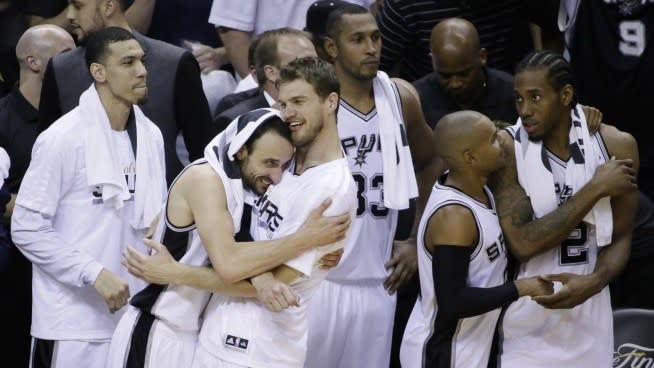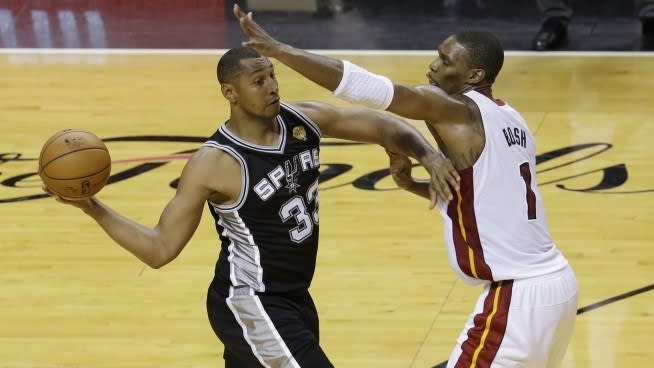How the San Antonio Spurs Turned a Group of Castoffs into Stars

Photo: AP Images
As the San Antonio Spurs pummeled the Miami Heat into submission during the 2014 NBA Finals, there were plenty of big plays from the players you've known for years: Tim Duncan, Tony Parker and Manu Ginobili. But perhaps the true heroes of the series were lesser-known names—guys like Patty Mills, a point guard whose previous team was the Xinjiang Flying Tigers. Or Boris Diaw, a once-fat Frenchman who was considered an antique by the lowly Charlotte Bobcats. Or Danny Green, who was cut by the Cleveland Cavaliers after just a single season and toiled for years in the NBA's D-League.
How did this cast of castoffs become key players on one of the most outstanding NBA Championship teams in recent memory? By buying in to coach Gregg Popovich's system, for one. And to Pop's credit, he adjusted that system to capitalize on his players' skills.
Here's how.
Boris Diaw

Photo: AP Images
Drafted by the Atlanta Hawks in 2003, Diaw was once billed as the “French Magic Johnson.”
The 6-foot-10 forward could move fluidly in the open court and handle the ball, as was evident in 2005-2006, when he averaged 6.2 assists per game as a member of the “7 Seconds or Less” Phoenix Suns. He contributed 13.3 points per game that year, then poured in 18.7 points per game in the playoffs.
He was big and quick enough to guard any position, and he shot 52 percent from the field. But after being traded to the Charlotte Bobcats in 2008, Diaw got, in a word, fat. His scoring average dipped to 7.4 ppg during the 2011-2012 season, and even Charlotte coach Paul Silas commented on how disappointed he was with Diaw’s weight gain.
Yet Diaw was reborn when he signed with the Spurs soon after being waived by the Bobcats in 2012.
He slimmed down and moved in with Parker, his childhood friend.
The Spurs took Diaw’s strengths—his passing and ability to defend almost anyone on the floor—and inserted them into a system predicated on ball movement and crisp defensive rotations, perfect for Diaw's talents. Averaging 9.1 points per game this season, his highest since 2010-2011, Diaw also reinvented himself as a 3-point shooter and a staple in the Spurs' non-stop offensive attack. He shot 40 percent from deep. He never even came close to that percentage during his heyday in Phoenix.
Diaw's passing wizardry was on display during the playoffs, especially during the Finals, where he averaged 5.8 assists per game, dishing out dimes to Duncan and Tiago Splitter in the paint and firing passes out to the perimeter for open 3-pointers. Popovich even had the luxury of sticking Diaw on Miami's LeBron James when his primary defender, Kawhi Leonard, got in foul trouble. Diaw more than held his own.
Kawhi Leonard

Photo: AP Images
Even though his San Diego State team went 34-3 during the 2010-2011 season, the soft-spoken Leonard was still relatively unknown by the time the NBA Draft rolled around. But the Spurs knew who he was and what they needed him to do.
Leonard’s scouting report pegged him as a complementary player—a guy with strong physical makeup and top-tier defensive abilities who was still fairly raw from an offensive standpoint, struggling to create shots for himself.
The Spurs thought otherwise. The team traded point guard (and Popovich-favorite) George Hill, along with two other players, to Indiana for Leonard, who had been selected 15th overall by the Pacers in the 2011 NBA Draft.
Behind Duncan and Parker, Leonard flourished as a five-tool player and had no trouble creating his own shot. He can dart to the wing and hit 3-pointers at a 38-percent clip, stick a jumper whenever he wants (he shot 52 percent from the field this season), drive to the rim for a vicious slam and defend the best players in the NBA with his length. He averaged almost two steals per game.
Leonard was magnificent in the 2014 playoffs, scoring 14 points per game and shooting over 40 percent from the 3-point line on his way to winning the Finals MVP award.
Not bad for a “complementary player.”
Danny Green

Photo: AP Images
Coming out of the University of North Carolina, Green was billed as a catch-and-shoot guy with a vastly improved 3-point shot and superb perimeter defense.
The Cleveland Cavaliers took Green with the 46th pick of the 2009 Draft, and Green was thrust into a bad situation. The Cavs were a championship contender with a deep, talented roster. Green found it almost impossible to break into the rotation, appearing in just 20 games and averaging only 5.8 minutes on the court.When he did get playing time, he was less than stellar, shooting a dismal 27 percent from beyond the arc.
The Cavs cut Green in the off-season, and he fell into the NBA Development League. He then spent some time overseas before the Spurs came calling.
Once again, San Antonio recognized a player’s skills and made the best of them.
The Spurs' offense, based on multiple passes and an array of player movement and cuts, allows Green to use his superb off-the-ball movement to find his spot beyond the 3-point line and bomb away from deep, much like Ray Allen has done for years.
Green honed his craft in San Antonio. His 3-point shooting percentage has hovered north of 40 percent for the past three seasons, including a ludicrous 48 percent in last year’s playoffs, where he broke Allen’s record for the most 3-pointers made in the NBA Finals with 27. He’s also a quietly good defender, both on the perimeter and in transition, where he is able to control his body extremely well without fouling.
Patty Mills

Photo: AP Images
Mills was out of the NBA.
Drafted by the Portland Trail Blazers in 2009, he headed for his native Australia to play ball during the NBA lockout in 2011, before jetting to China to play in Xinjiang. He was released by the team in 2012, and the Spurs took a flier on him.
A quick point guard with an explosive first step and silky jumper, Mills was also known for his quick trigger and poor shot selection coming out of college, where he took twice as many outside jumpers and shots beyond the 3-point line as he did inside the paint. To make matters worse, Mills shot only 34 percent from 3-point land during his final season at Saint Mary’s College, and he didn't improve much during his first two years in Portland.
But Mills’ weaknesses have become his strengths in San Antonio. The Spurs' rapid ball movement allows him to get wide-open around the 3-point arc, where his quick trigger is no longer a detriment. He shot 42 percent from deep this season after working closely with Spurs shooting coach Chip Engelland to speed up and heighten his release.
When Mills gets hot, like he did in Game 5 of the Finals, it can completely change the course of a game. His quick shooting motion also helps him get 3’s up and over defenders.
This article originally appeared on STACK.com: How the San Antonio Spurs Turned a Group of Castoffs into Stars



